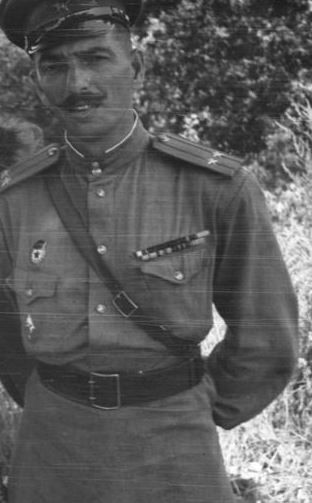Semion Bliumenkrants was born in 1914 in Kremenchug, Ukraine. In the mid-1930s, he was qualified as a construction engineer and worked at the Moscow-based Chief Directorate of the Northern Sea Route. According to some sources, in 1938, during Stalin's "purges" of this directorate, Bliumenkrants lost his job. However, instead of being executed, he was deported to the Soviet Far East. From 1938 to 1941, he worked in the Soviet Far East and in the Kolyma region (in the Soviet Arctic) as an employee of the NKVD (precursor of the KGB) Administration for Dalstroi (abbreviation for Far Eastern Construction).
With the beginning of the Soviet-German war in June 1941, Bliumenkrants was drafted into the Red Army. After starting as an infantryman, he was sent to officers' school. After graduating, Bliumenkrants served as a staff officer in various units. In 1942 and 1943, he took part in the Stalingrad operation. On January 31, 1943, as chief of staff of the 1,326th Infantry Regiment, Captain Bliumenkrants accepted the surrender of the German Lieutenant-General Alexander Edler von Daniels, the commander of the Wehrmacht's 376th Infantry Division. Following the end of the Stalingrad operation, Bliumenkrants was awarded the Order of the Patriotic War, 2nd Class. During the following years, he took part in the Kursk Salient operation (during which he was wounded), and in battles in Romania and Hungary. Despite his being a staff officer, more than once, he took part in a combat. In January 1945, he was wounded again. By the end of the war, Lieutenant-Colonel Bliumenkrants had been awarded four military orders.
After the war, Semion Bliumenkrants continued in army service. He retired in the 1960s and settled in Riga, Latvia, where he continued to work at his previous profession of construction engineer. He died in 1989.
In an article prepared for Eynikayt, Russian Jewish writer and journalist, Viktor Fink recounts how Blumenkrants accepted the surrender of the German General Edler von Daniels in Stalingrad
"Once in the middle of the night, the chief of the HQ of a Red Army infantry regiment Captain Bliumenkrants was awakened by a phone call. An outpost reported that five German officers had asked for permission to be allowed in: they were truce envoys from the command of the German 376th Infantry Division. The chief of the HQ ordered them to be allowed to enter. The five German officers entered, clicked of their boots, saluted, and said:
'Lieutenant-General Alexander Edler von Daniels, the commander of the Wehrmacht's 376th Infantry Division, believes that continued resistance is senseless and he wishes to surrender with the rest of his division. He is asking about the terms [you propose]."
Major (sic!) Bliumenkrants said to the truce envoys that their general had a good idea because an order had been issued to begin an artillery bombardment of the division's positions at 8 a.m. -- with the aim of wiping out his division. [...] Concerning the terms, he said, that he would have to contact the command. [...] The conditions were very simple: surrender is surrender, so the remnants of the division would have to assemble at a stipulated point and the General would have to report in person to the Red Army headquarters. Two Soviet officers -- Bliumenkrants and Sorokin, a telephone operator -- and two of the German truce envoys set out in order to inform General Edler von Daniels of the conditions. Sima [nickname for Semion] Bliumenkrants burst out laughing and continued:
'[…] We arrived. They brought us to some underground construction and took the blindfolds off our eyes. I could see a well-furnished room, with good furniture and carpets. There were several German officers in the room, among them the lieutenant general. The translator introduced us:
– Captain Sorokin.
The Germans clicked their heels and shook hands stiffly [with the first Soviet officer].
[Then they were introduced to the other Soviet officer]: 'Captain Bliumenkrants.'
[Hearing the latter name,] the Germans shuddered because that sounded like a German name, but the appearance of its bearer was definitely not that of an Aryan. However – they again clicked their heels again and stiffly shook hands [with the other Soviet officer].
Bliumenkrants informed the general of the location to which he had to bring the remainders of his division, and added that he should hurry since it would soon be 8 a.m., when the [Red Army] artillery begin firing.
General von Daniels proposed having a meal before they left. In an adjacent room a table was set with a snow-white tablecloth, crystal goblets, and a silver utensils. Everything was elegant except for the fact that the meal consisted of canned food and hard rusks.
'It would be good to have something to drink, but we don't have anything' one of the Germans remarked.
However, the Soviet truce envoys had brought something to drink since a Russian general had sent some food to his prisoner.
Bliumenkrants brought von Daniels to the Red Army headquarters. It was quite light outside by this time. Cameramen were standing ready outside the headquarters. Their footage was later included in the documentary 'Stalingrad'.
– My mission was finished, – Sima [Bliumenkrants] said. – I handed over the general, and never saw him again. But what interests me greatly was whether Hitler knew that the commander of a division whom he sent to Stalingrad to finish the war with a victory, in fact finished it in the hands of a Jewish officer. I wanted Hitler to know this. I wanted him to choke."
GARF 8114-1-160, p. 298-300, copied by Yad Vashem: JM 26142, frame 241-244.







